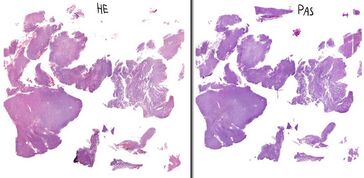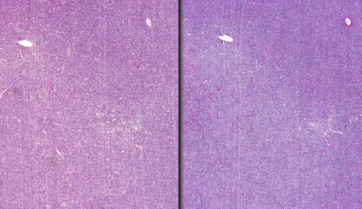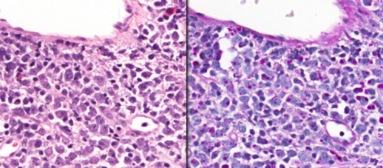18. Diffuse large B-cell lymphoma (DLBCL): Difference between revisions
(Created page with "'''Staining''': HE and PAS '''Organ''': Lymph node (not recognizable) '''Description''': No healthy lymph node tissue is visible. The tumor cells form no structures (like glands or nests). The cells are large and show severe atypia/pleiomorphism, almost anaplastic. The cells resemble centroblasts and are therefore said to be centroblastic in appearance or ''centroblastoid.'' There is high mitotic activity (many mitotic figures). On PAS staining are PAS-positive inclu...") |
No edit summary |
||
| Line 1: | Line 1: | ||
'''Staining''': HE and PAS | [[File:DLBCL - overview.jpg|thumb|Overview|364x364px]]'''Staining''': HE and PAS | ||
'''Organ''': Lymph node (not recognizable) | '''Organ''': Lymph node (not recognizable) | ||
'''Description''': | '''Description''':[[File:DLBCL - middle magnification.png|thumb|The tumor cells form no structures. HE on the left and PAS on the right.|362x362px]]No healthy lymph node tissue is visible. The tumor cells form no structures (like glands or nests). The cells are large and show severe atypia/pleiomorphism, almost anaplastic. The cells resemble centroblasts and are therefore said to be centroblastic in appearance or ''centroblastoid.'' There is high mitotic activity (many mitotic figures). | ||
No healthy lymph node tissue is visible. The tumor cells form no structures (like glands or nests). The cells are large and show severe atypia/pleiomorphism, almost anaplastic. The cells resemble centroblasts and are therefore said to be centroblastic in appearance or ''centroblastoid.'' There is high mitotic activity (many mitotic figures). | |||
On PAS staining are PAS-positive inclusion bodies in the cytoplasm and nuclei visible, so called Russell bodies and Dutcher bodies, respectively. These inclusion bodies are comprised of immunoglobulin. | On PAS staining are PAS-positive inclusion bodies in the cytoplasm and nuclei visible, so called Russell bodies and Dutcher bodies, respectively. These inclusion bodies are comprised of immunoglobulin. | ||
'''Diagnosis''': Diffuse large B-cell lymphoma. | '''Diagnosis''': Diffuse large B-cell lymphoma.[[File:DLBCL - high magnification.png|thumb|Look at this|383x383px]]'''Causes''': | ||
'''Causes''': | |||
* Primary type: mutations in | * Primary type: mutations in | ||
| Line 22: | Line 18: | ||
Necrosis is also a common histological finding in DLBCL but it can’t be seen here. | Necrosis is also a common histological finding in DLBCL but it can’t be seen here. | ||
[[Category:Pathology 2 - Histopathology slides]] | [[Category:Pathology 2 - Histopathology slides]] | ||
Latest revision as of 13:47, 7 July 2024

Staining: HE and PAS
Organ: Lymph node (not recognizable)
Description:

No healthy lymph node tissue is visible. The tumor cells form no structures (like glands or nests). The cells are large and show severe atypia/pleiomorphism, almost anaplastic. The cells resemble centroblasts and are therefore said to be centroblastic in appearance or centroblastoid. There is high mitotic activity (many mitotic figures).
On PAS staining are PAS-positive inclusion bodies in the cytoplasm and nuclei visible, so called Russell bodies and Dutcher bodies, respectively. These inclusion bodies are comprised of immunoglobulin.
Diagnosis: Diffuse large B-cell lymphoma.

Causes:
- Primary type: mutations in
- Myc
- BCL2
- BCL6
- Secondary type: Richter transformation from CLL, MZL or FL
Theory:
Necrosis is also a common histological finding in DLBCL but it can’t be seen here.
